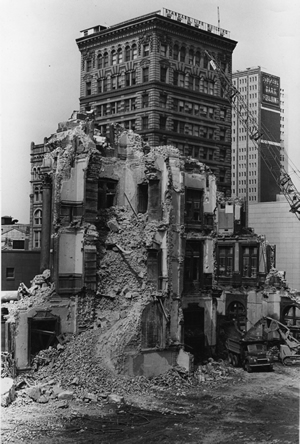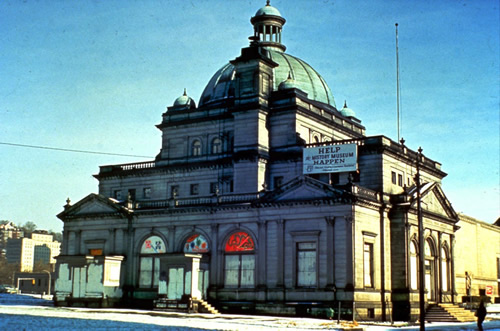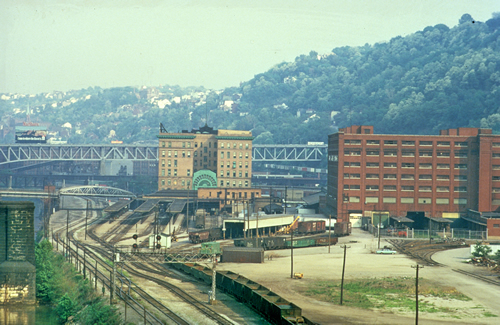
History

PHLF was founded in opposition to the demolition of the failed “urban renewal” policies
The Pittsburgh History & Landmarks Foundation (PHLF) was founded in 1964 by a group of citizens who passionately believed that historic preservation, rather than massive demolition, could be a tool for renewing communities, creating pride among residents, and achieving sustainable economic development.
Recognized as one of the nation’s most innovative and effective nonprofit historic preservation organizations, PHLF works to, identify and save historically significant places; renew historic neighborhoods, towns, and urban areas; preserve historic farms and historic designed landscapes; and educate people about the Pittsburgh region’s rich architectural heritage.
At the time of PHLF’s founding, vast amounts of public money were being spent to replace some of Pittsburgh’s most historic neighborhoods and commercial areas with characterless architecture, parking lots and roadways. In the 1950s and 1960s in Pittsburgh as in many other cities, “urban renewal” meant destroying much of the existing built environment. Pittsburgh’s “Renaissance” mayor David L. Lawrence was quoted as saying, “The town has no worship of landmarks. Instead, it takes pleasure in the swing of the headache ball and the crash of falling brick.”
It was in this environment that PHLF was born, and as the organization evolved, urban renewal and planning agencies began to alter to some extent their “tear it down” policies. In 1967, PHLF worked with the City of Pittsburgh’s Department of Planning to prepare an historic preservation ordinance for the city, which was adopted in 1971. The Urban Redevelopment Authority commissioned PHLF to do a preservation study of Manchester, an historic neighborhood on the city’s North Side, as early as 1970, and surveys were subsequently performed for URA, the Allegheny Conference on Community Development, and various city and county agencies.
Early success in Manchester

PHLF started its work in neighborhoods on Liverpool Street in Manchester
For PHLF, it all started in the 1300 block of Liverpool Street, in a predominantly African American community on the city’s North Side. There, PHLF established a revolving Preservation Fund and began to work aggressively to save and restore buildings in historic neighborhoods.
In Manchester, primarily a neighborhood of impressive red brick houses with stone trim and wooden porches set on an orderly street grid, PHLF worked with neighborhood residents to create the first historic preservation district in the nation primarily for African Americans; the first preservation program using urban-renewal funds for the restoration of houses for low-to moderate-income residents and a series of incentive programs designed to combat displacement and encourage longtime residents to stay and become part of a revitalized community.
PHLF nominated and listed Manchester on the National Register of Historic Places in 1975 and in 1979, it was designated a City Historic District.
In Manchester, PHLF also helped organize residents into what is now the Manchester Citizens Corporation and in the Mexican War Streets, PHLF began an experimental program, the first of its kind in the nation, in conjunction with the Pittsburgh Housing Authority to restore dilapidated buildings and houses while maintaining affordable housing for the community thus avoiding dislocation of the neighborhood residents.
The organization became adept at innovative financing, simultaneously exploring creative uses of government programs in ways that accomplished preservation goals and developed the assets of the revolving preservation fund generously supported by Pittsburgh’s philanthropic foundations.
PHLF has always preferred to work with and support established neighborhood community organizations, offering services and administering funding for neighborhood projects through established community-based groups.
To that end, PHLF also worked actively with neighborhood residents to form such organizations where none existed like the Manchester Citizens Council and the Mexican War Streets Association, two important civic groups. The most notable achievement of this kind is undoubtedly the Pittsburgh Community Reinvestment Group (PCRG), originally an umbrella organization of community groups founded in 1988. These organizations continue today.
Saving the former Allegheny Post Office building
Beyond Manchester and the Mexican War Streets, one of PHLF’s early and important historic preservation victories on the North Side was the fight to save the former Allegheny Post Office, a grand Italian Renaissance building of 1897 and one of the few public buildings of the City of Allegheny to survive the demolition of the Central North Side. The building was saved when PHLF agreed to purchase and occupy it following a 1969 PHLF proposal to restore the building and transform it into a museum of Pittsburgh and Allegheny County history as well as a vital development centerpiece on the North Side.

PHLF led the effort to save the former Allegheny Post Office building, which now houses Children’s Museum of Pittsburgh
Renamed the Old Post Office Museum, the building served as the headquarters of PHLF starting in 1971 and housed architectural artifacts salvaged from demolished buildings, and a sculptural garden included sculptures that had been salvaged from the former Manchester Bridge, which was demolished in 1970. The building would be the home of PHLF until 1985 when a new use for it was proposed as the home of the Pittsburgh Children’s Museum. PHLF gave the building and garden to Children’s Museum in 1989.
Station Square and Preservation in Downtown
In the mid 1970s, PHLF began its most ambitious and successful program, the redevelopment of Station Square, a riverfront development along the Monongahela directly opposite Downtown Pittsburgh. PHLF conceived the idea in 1975 when there was talk of tearing down some of the under-utilized Pittsburgh & Lake Erie Railroad buildings, which were constructed between 1897 and 1917. Although few Pittsburgh leaders and politicians believed that PHLF would be successful, the Allegheny Foundation, a Scaife Family charitable trust generously provided PHLF with an initial $5 million equity grant and supported the development for two decades.
From 1976 to 1984, PHLF would serve as the prime developer of the site, eventually acquiring 52 acres of riverfront property, where PHLF was able to put its principles into practice:
- Historic buildings were reused for offices, shops, restaurants, and entertainment;
- Parking was conveniently placed near buildings;
- Open squares and landscapes were humanly scaled;
- Artifacts such as a paddlewheel, Bessemer converter, blowing engine, and bridge finial were treated as sculpture;
- And, for the first time in Pittsburgh, underdeveloped riverfront land was utilized as an amenity for people.

In 1976, PHLF started the acquisition of a 52-acre rail road yard along the Monongahela, redeveloping it into Station Square, an office, retail, and entertainment complex on Pittsburgh’s South Side
Five historic railroad buildings were adapted for new uses, and a hotel, a dock for the Gateway Clipper fleet, and parking areas were added. PHLF developed Station Square without using city, county, or state funds, and repaid a federal loan ahead of schedule. The total investment by PHLF and its sub-developers was over $100 million. Upon completion of Station Square, PHLF had taken a site that generated $47,000 in real estate and nothing in parking taxes to one that produced $4 million a year in real estate and parking taxes, created 3,000 jobs, with 143 businesses.
When PHLF sold Station Square in 1994 because its historic preservation goals had been achieved, the sale proceeds of about $25 million plus continuing economic participation were added to funds that help continue the organization’s work in neighborhood revitalization, historic preservation programs, and educational activities. PHLF is only one of few such organizations in the preservation field that has been able to generate revenue while putting its mission to practice.
Now owned by Forest City Enterprises, Inc., a Cleveland-based real estate developer, Station Square continues to be a popular Pittsburgh destination, which offers commercial office space, entertainment, parking convenient to Downtown Pittsburgh, riverboat entertainment, and other amenities.
The work continues…
Activist, innovative, practical, fiscally prudent and resourceful, persistent, flexible, and egalitarian: these qualities characterize PHLF’s commitment to preservation of the past. Through its work, PHLF is improving the quality of life for Pittsburghers and attracting tourists to the region.
In Downtown Pittsburgh, PHLF continues displaying those characteristics and principles through preservation easements that protect buildings, restoration that creates commercial retail spaces and housing in historic buildings, and is helping to renew the economic vitality of the central business district.

PHLF’s Market at Fifth development helped revitalize Downtown’s Market Square
In 2015, PHLF, together with private developers, the City of Pittsburgh’s Urban Redevelopment Authority, the Commonwealth of Pennsylvania, other nonprofit organizations and small business owners are all contributing to the burst of renovation activity that is creating a stimulating and economically vital downtown with national architectural distinction.
To that end, PHLF completed the restoration of 11 historic facades on 10 buildings in the core business district of Downtown in 2015, helped launch a new grocery store—Market Street Grocery— the first of its kind back in Downtown’s Market Square for many years, and is working on upper floor development of spaces in historic buildings in Market Square and on Wood Street.
Broad Historic Restoration Program in Wilkinsburg
In Wilkinsburg, a low-to moderate-income bedroom community six miles due east of Downtown, PHLF is continuing a comprehensive historic preservation initiative in partnership with Allegheny County, the Wilkinsburg Community Development Corporation with funding from TriState Capital Bank, through a state tax credit initiative, the Neighborhood Partnership Program.
Over the last 10 years, PHLF’s work in the Hamnett Place neighborhood, a National Register-listed historic district saw the restoration of seven single-family houses, which were sold to new residents, two apartment buildings that provided 27 units of affordable housing and the creation of two gardens on formerly blighted vacant lots.

The restored Crescent Apartments building is a major part of PHLF’s broad historic restoration efforts in Wilkinsburg
In addition, PHLF restored a former auto repair shop into a state-of-the-art learning and meeting space now known as the Landmarks Preservation Resource Center, where the organization offers demonstration workshops on DIY house restoration techniques, seminars, lectures, and film screenings on historic preservation, architectural history, urban planning and community development.
In 2015, PHLF will start restoration work on the Falconhurst Neighborhood Restoration Development Program, a multi-site project that will create 33 more affordable housing units and newly constructed buildings in the Hamnett Place neighborhood.
Through it all, the work of PHLF continues to be guided by the principles of place making espoused by its leader and co-founder, Arthur Ziegler when he notes that, “through the place, we renew the spirit of the people. Historic preservation can be the basis of community renewal, human renewal, and economic renewal. Preservation is not some isolated cultural benefit.”
Today, historic buildings in Downtown, homes in neighborhoods such as Manchester, on Pittsburgh’s North Side, stores on main streets such as East Carson, on the South Side, and the historic buildings housing shops and restaurants at Station Square, a 51-acre former railroad yard, and restored houses in Wilkinsburg, survive and flourish and attract people by their architectural uniqueness, human scale and urban character, thanks in large part to the work and determination of this organization.
Although its primary focus is on the Pittsburgh area, the Pittsburgh History & Landmarks Foundation is chartered to work within a 250-mile radius of Pittsburgh, Pennsylvania.
PHLF includes subsidiaries:
Landmarks Community Capital Corporation (LCCC), a non-profit lending subsidiary, which makes loans and obtains grants and investment capital, used to finance and develop projects that assist in the revitalization of urban centers, towns, and neighborhoods.
Landmarks Development Corporation (LDC), a for-profit real estate development company that provides consulting services and develops real estate.
PHLF is supported by more than 2,000 members, and guided by 25 trustees, with 23 staff members and more than 75 volunteers.
